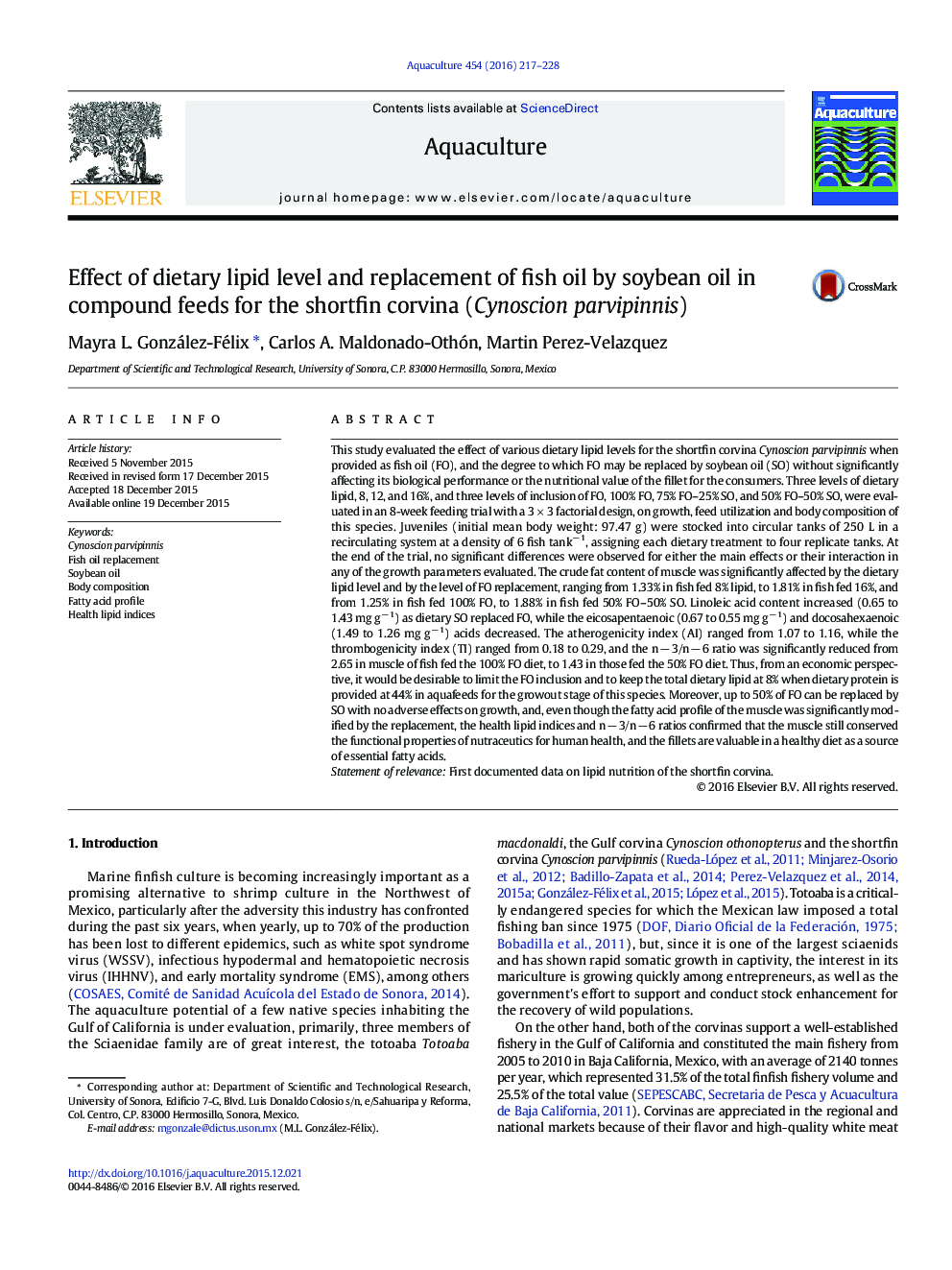| کد مقاله | کد نشریه | سال انتشار | مقاله انگلیسی | نسخه تمام متن |
|---|---|---|---|---|
| 2421504 | 1552833 | 2016 | 12 صفحه PDF | دانلود رایگان |

• No effect of increasing dietary lipid from 8 to 16% was observed on growth of the shortfin corvina.
• From an economic perspective, it is desirable to limit total dietary lipid to 8% when fed 44% crude protein.
• Up to 50% of fish oil can be replaced by soybean oil with no adverse effects on growth.
• Health lipid indices and n − 3/n − 6 ratios indicated that muscle preserved functional properties of nutraceutics for human health.
This study evaluated the effect of various dietary lipid levels for the shortfin corvina Cynoscion parvipinnis when provided as fish oil (FO), and the degree to which FO may be replaced by soybean oil (SO) without significantly affecting its biological performance or the nutritional value of the fillet for the consumers. Three levels of dietary lipid, 8, 12, and 16%, and three levels of inclusion of FO, 100% FO, 75% FO–25% SO, and 50% FO–50% SO, were evaluated in an 8-week feeding trial with a 3 × 3 factorial design, on growth, feed utilization and body composition of this species. Juveniles (initial mean body weight: 97.47 g) were stocked into circular tanks of 250 L in a recirculating system at a density of 6 fish tank− 1, assigning each dietary treatment to four replicate tanks. At the end of the trial, no significant differences were observed for either the main effects or their interaction in any of the growth parameters evaluated. The crude fat content of muscle was significantly affected by the dietary lipid level and by the level of FO replacement, ranging from 1.33% in fish fed 8% lipid, to 1.81% in fish fed 16%, and from 1.25% in fish fed 100% FO, to 1.88% in fish fed 50% FO–50% SO. Linoleic acid content increased (0.65 to 1.43 mg g− 1) as dietary SO replaced FO, while the eicosapentaenoic (0.67 to 0.55 mg g− 1) and docosahexaenoic (1.49 to 1.26 mg g− 1) acids decreased. The atherogenicity index (AI) ranged from 1.07 to 1.16, while the thrombogenicity index (TI) ranged from 0.18 to 0.29, and the n − 3/n − 6 ratio was significantly reduced from 2.65 in muscle of fish fed the 100% FO diet, to 1.43 in those fed the 50% FO diet. Thus, from an economic perspective, it would be desirable to limit the FO inclusion and to keep the total dietary lipid at 8% when dietary protein is provided at 44% in aquafeeds for the growout stage of this species. Moreover, up to 50% of FO can be replaced by SO with no adverse effects on growth, and, even though the fatty acid profile of the muscle was significantly modified by the replacement, the health lipid indices and n − 3/n − 6 ratios confirmed that the muscle still conserved the functional properties of nutraceutics for human health, and the fillets are valuable in a healthy diet as a source of essential fatty acids.Statement of relevanceFirst documented data on lipid nutrition of the shortfin corvina.
Journal: Aquaculture - Volume 454, 1 March 2016, Pages 217–228